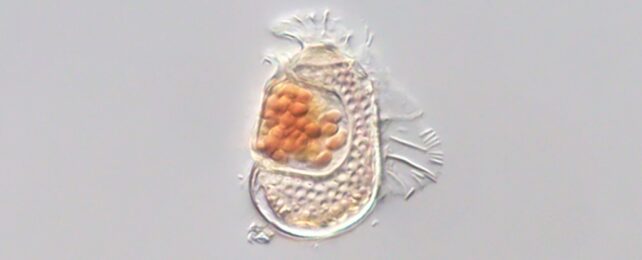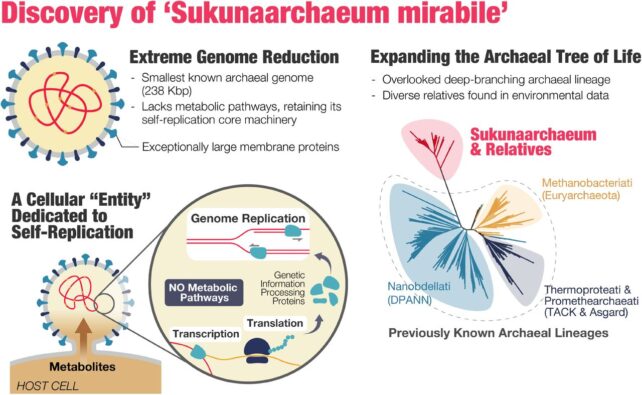 Within this dinoflagellate plankton is a tiny microbe that acts more like a virus than a cell. (Takuro Nakayama/University of Tsukuba)
Within this dinoflagellate plankton is a tiny microbe that acts more like a virus than a cell. (Takuro Nakayama/University of Tsukuba)
Within a tiny plankton, an even smaller cell has been found living an unexpectedly virus-like existence, challenging what it means to be alive.
The line between living and inanimate has traditionally and controversially been drawn before viruses, and the newly discovered organism, provisionally named Sukunaarchaeum mirabile, skates awfully close to it.
Dalhousie University genomicist Ryo Harada and colleagues stumbled across the odd parasite while they were trying to catalog the DNA of the plankton species Citharistes regius and its symbiotic bacteria.
A strange, tiny loop of DNA suggested the presence of another entity – one that didn't neatly fit into known categories.
"Sukunaarchaeum may represent the closest cellular entity discovered to date that approaches a viral strategy of existence," the researchers write in their paper.
"This extreme specialization… challenges our fundamental understanding of the minimal requirements for cellular life."
Related: Hundreds of Mysterious Giant Viruses Discovered Lurking in The Ocean
Sukunaarchaeum only has 238,000 base pairs of DNA, yet some viruses reach 735,000 base pairs or even 2.5 million.
Like viruses, Sukunaarchaeum delegates most of its biological functions, including metabolism, to its host. And also like viruses, most of the cell's genes are dedicated to one thing: replicating itself.
"Its genome is profoundly stripped-down, lacking virtually all recognizable metabolic pathways, and primarily encoding the machinery for its replicative core," Harada and team explain.
"This suggests an unprecedented level of metabolic dependence on a host, a condition that challenges the functional distinctions between minimal cellular life and viruses."
 Properties of the newly discovered Sukunaarchaeum mirabile. (Harada et al., BioRxiv, 2025)
Properties of the newly discovered Sukunaarchaeum mirabile. (Harada et al., BioRxiv, 2025)Unlike viruses, however, Sukunaarchaeum still has the genes to create its own DNA replication proteins, including ribosomes, messenger RNA, and transfer RNA. Whereas, viruses hijack their hosts' replication machinery.
What's more, Sukunaarchaeum produces proteins that are likely involved in forming a membrane to house its tiny circle of DNA, potentially helping with its interactions with its plankton host.
Shared genes suggest Sukunaarchaeum belongs to archaea, the domain of life from which our group, eukaryotes, evolved. Its circular chromosome resembles the genetic material of bacteria and archaea.
With no genes for metabolism, Sukunaarchaeum doesn't appear to offer anything in return for the biological functions it commandeers from the plankton.
Viruses are generally not considered alive in part because they can't replicate or sustain themselves without machinery provided by their host. Sukunaarchaeum can replicate, but not sustain itself, making that line between life and non-life even more precarious.
This research has been uploaded onto bioRxiv and has yet to be peer reviewed.
.png)



